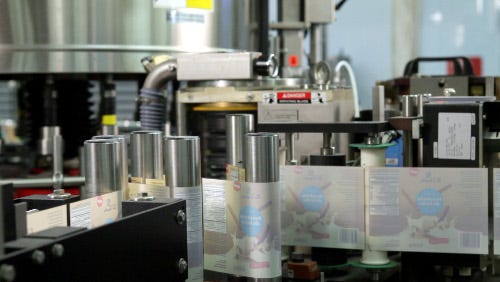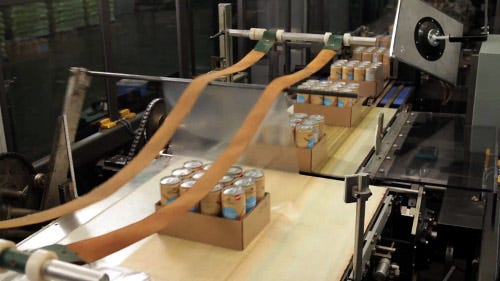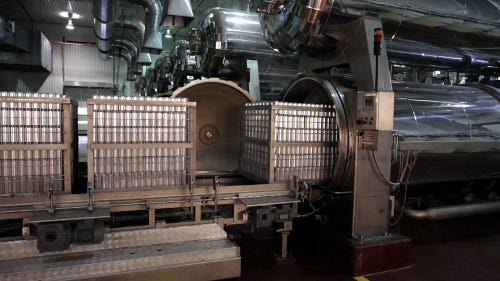Proving out new packaging technology is never easy. It takes time and commitment; and often hinges on assembling just the right team to pull it off.
On May 24, 2011, national co-op Dairy Farmers of America (DFA) successfully launched La Vaquita licuados, a new dairy-based beverage that represents the first commercial application of roll-applied shrink (RAS) labeling from Eastman Chemical Co. DFA was able to use an existing packaging line in its Cabool, MO, plant to run the new product in what Darold Sauber, director of business development, contract manufacturing at DFA, describes as a "seamless transition."
DFA La Vaquita licuados
Getting here took several years and a dream-team of suppliers working together to advance the technology. But now DFA has the in-house capability of doing high-impact graphics on shaped containers, as well as the production flexibility to do high-speed short runs of customized labels for product launches and/or special promotional packs. These two advantages—shelf impact and target marketing—are key to the success of the company's own brands, as well as for its contract manufacturing business, which serves other brand owners.
A con(census)
Like most packaging projects, this one starts with the product. La Vaquita is the second largest Hispanic brand in the country, recognized for its artisan cheeses and dips. The new product is a shelf-stable blended beverage of low-fat milk and natural and artificial flavors (similar to a smoothie) that is popular in many acculturated and non-acculturated Hispanic households.
It's available in three flavors—dulce de leche (caramel), naranja (orange) and horchata (cinnamon)—and will be sold, initially, at Wegmans grocery stores in the northeast U.S., with immediate plans to expand in the Texas market.
DFA developed this beverage to take advantage of what it sees as an incredible market opportunity for products targeted to Hispanics, one of the fastest growing segments of the population, according to the 2010 census. Many Hispanics have grown up with licuados beverages and consume them throughout the day.
But DFA sees the La Vaquita licuados beverages as having appeal beyond the ethnic market, too, as a great-tasting drink for all Americans that Janine Smiley, DFA's director of industry communications, says delivers a lighter taste because it's made with low-fat milk. "Satisfying without feeling full," is how she describes the consumer's experience.
The package, a 9.5-oz aluminum slim-line can supplied by Rexam, sells the authenticity of the La Vaquita brand through high-impact full-body graphics and bilingual messages. Currently, the single-serve cans are sold separately, but Sauber says they are considering a 4-pack multipack for the future.

DFA labeler
Shrink still growing
DFA opted for the new RAS technology because, Sauber explains, "RAS helped us with a new label that would seal and form to the cans better than other polyethylene labels."
Preston Salyer, Eastman's sales development manager for shrink film, says that RAS helps fill the gap between roll-applied non-shrink labels and conventional shrink-sleeve labels, which can shrink up to 75 percent. Machine-direction RAS films made from Eastman's copolyester resins are now commercially available with 65-percent ultimate shrink capability.
The La Vaquita can is low shrinkage, at less than 10 percent. But Sauber says they didn't want a loose label at the top of the necked-in can, and RAS shrinks tight to present a nice-looking label all around. It doesn't crinkle or shift to mar the brand image or user's experience. "We intend to use it in the future with other cans with smaller neck finishes," Sauber says, citing the industry trend of narrower necked-in cans to save material and hit sustainability targets.
One of the reasons for the explosive growth of shrink labels in the last 10 to 15 years is that shrink lets brands create stunning, high-gloss 360-deg graphics on shaped or contoured containers. And RAS gives users of roll-on labelers an option to better fit colorful decoration to bottle contours without making an investment in shrink-sleeve equipment.
Shrink labeling also gives brand owners the ability to customize graphics, almost on the fly, for short runs—something a printed can with minimum order quantities isn't so good at.
Sauber says this capability is a big plus, especially for DFA's contract manufacturing business. "Short runs are vital to launch new products. Unless you're a company where you've got instant national distribution, it's hard for a lot of brand owners to develop new products and get them to a launch state without going into financial bankruptcy," he says.
Howdy, pardner
This project required the collaboration of DFA and its packaging materials and equipment suppliers, each contributing a critical component.
Eastman supplies the resin, which is made into film by Klöckner Pentaplast. CL&D Graphics prints and converts the film into shrink-label rollstock. Minor modifications were made to DFA's existing labeler, a Krones Contiroll. And the final piece, a solvent adhesive from Flexcraft Industries Inc., literally sealed the deal.

DFA labeler 2
Dave Niemuth, director of labeling technology in North America at Krones, says collaboration was imperative. "If we were still using hot melt, we wouldn't have been successful," he says, adding, "Marketing wouldn't have liked how the package looked. We tried to label with standard hot melt. We used the best hot melt we could find. But when it ran through the tunnel, the label would split open in the contour area."
David Kater, business manager, specialty films, at Klöckner Pentaplast, offers, "What's interesting about this project is it took all of us to come together as a group to prove out this application. Trying to do this on your own would have been tough. I don't think it would have been achievable, frankly. Everybody had a portion of the technology knowledge. Bringing it all together really formed the final project. We would definitely do it again."
Sauber says the capper for DFA was how easy it all went. "The actual beauty of this was that there were no challenges. The package, being that size aluminum can, is a can we run all the time, whether we're putting a label on it or whether it's a printed can. We have a Krones Contiroll machine that does roll-fed applications and the RAS film fit on it fine—no complications—and ran through the machine without any challenges at all. It was a seamless transition."
But the entire packaging community profits when new technology is proven like this. Niemuth from Krones admits that there was a learning curve with the DFA project but that it will be much easier and faster to do the next application of RAS technology. "Machine number two would be easy to get running," he asserts.
Here's how they got all the pieces fit.

DFA filler
The label material
On the material side, it starts with the resin, Eastman's Embrace RAS. One of a family of resins, this co-polyester based material features high gloss, toughness, shrinkability and excellent printability.
Klöckner Pentaplast formulated a proprietary film from the resin to create the needed properties for this and similar applications, including uniform shrinkage (there's no puckering through shrink process), optimal gloss for shelf pop, and easy processing through printing and labeling. KP's Kater explains that the film is augmented so it requires little effort on a customer's part to run it. The film's processing aids enhance productivity down the supply chain and minimize operating costs.
Dubbed Pentalabel PETG LG20/30, the 50-micron film provides shrinkage of 55 percent at 95-deg C in 30-sec in water. It also performs well with solvent seaming, which is how DFA seals the trailing edge of the label for the film-on-film bond.
The printing
The RAS labels can pretty much be printed like any other shrink sleeve or roll label. This label is reverse printed on a flexographic press using nine of the available 10 stations.
CL&D Graphics Inc. wrote functional specifications to convert the package art to print-ready files, produced plates and made the Klöckner Pentaplast material into printed roll-fed film labels for each of the production trials. They used both water- and solvent-based shrinkable inks, partially for graphic impact and partially for automation assistance. The inks help at various touch points on the machinery, such as when the film is cut and gripped as the label is applied to the container.
The solvent
The leading edge of the labels are tacked to the can with hot melt, but the trailing edge needed something else because hot melt is limited in how much it can shrink. Flexcraft's solvent sealant solved that issue. Sauber says, "It allows us to get a smooth seal and makes the label look nice on the outside."
The 1540DM solvent adhesive is:
• Non-flammable, so the sealant can be used with a variety of shrink tunnels (hot air, infra-red and steam).
• Fast acting because the labeler is running at 600 units/min and because the cans go right into the shrink tunnel. The label needs to bond quickly down the entire length of the label so it doesn't shift before shrinking to the package.
• Low-odor: Flexcraft formulated a fast-acting sealant without the chemical tetrahydrofuran (THF), which has an obnoxious odor, so the workplace environment is better for operators and technicians.
Flexcraft's president/director Bruce Machleder also explains, "Hot melt on the trailing edge could squeeze out and create problems down the line on the equipment. Or a misfire or mislabel, with solvent system, it's not a major clean up. Hot melt could take 10 to 15 minutes to clean up. This makes production faster and cleaner for the operation."

DFA tray wrapper
The machine
The roll-fed labeler, a Krones Contiroll 745 series, was installed at DFA in 2005 to run necked-in cans. The rotary unit has 24 bottle stations and two separate labeling stations for high-speed application—each station labels every other can. As mentioned earlier, DFA is running the system at 600 cans/min (the same speed as other products that run on this line), but the system's range is from 100 to 750 units/min.
The two labeling stations are set up for hot melt on the leading edge and solvent on the trailing edge to run the new product. But the labeler can switch to hot melt/hot melt to run conventional film labels.
Cans are fed into the machine in single file through a feed screw to separate them as they enter the infeed starwheel, which rotates 360 deg, and are placed onto one of the 24 bottle plates. A spring-loaded centering bell holds the cans in place from the top as they spin on the rotating bottle table.
Labelstock is fed through the machine by pulleys and rollers. A photoeye sees the printed I-mark on the label and cuts it with a rotary knife. The material transfers to a vacuum gripper cylinder and then the leading edge of label passes over a hot melt glue roller and then is applied to a can. As it rotates around, a cam-controlled pusher/gripper pushes the label's trailing edge against a wicking bar (like felt) to apply solvent, which is then wiped down as the can continues to rotate. Once the label is wiped down, a chemical reaction takes place with material and solvent to bond before going through tunnel, creating a smooth seam.
According to Niemuth, there was a bit of trial and error at DFA because they were working with a new film and new solvent to get the best dwell times, rotational speed, solvent mixture and, especially, temperature settings. The solvent is at room temperature to activate the bond without melting the material. Krones sent the same service technician back into the DFA plant each time, Niemuth says, "Because we learned each time and then built on those learnings."

DFA retort
Popularity contest
One successful project is worth celebrating, but most members of this team are nearly giddy thinking about the potential explosive growth of roll-applied labeling.
"I think this will be the next major growth in the shrink label market," Machleder says. "There are a lot of Contirolls out there at brand owners and co-packers. The equipment is evolving to take advantage of what these films can do."
"RAS is one of the most up-and-coming labeling applications that we're seeing," Niemuth says. "We're seeing that a shaped container sells, better than a straight-walled container. RAS can only grow in its popularity."
Chuck Sims, labeling and graphics technologies manager at CL&D Graphics, also believes that shape sells and that's reason enough to consider this. But he also points out other, more bottom-line, reasons. "If customers with conventional roll-fed assets do a retrofit, the capital investment is minimized. The end user enhances the skill level in the plant, effectively cultivating the shrink market." Additional training for operators and maintenance workers would be virtually non-existent.
The technology could easily cross over to other markets, too, such as personal care products (shampoos or lotions), household chemicals (cleaners) and automotive aftermarket items (motor oils). According to Machleder, Krones labelers can accommodate packages with other shapes—square or oblong—which can open up the technology to other applications as well.
At this point, though, because it was the one to prove the viability of RAS technology, DFA hopes to corner the dairy beverage market through its contract business.
"At the moment, our line will handle the capacity that we have," Sauber says. "But I'm constantly out at trade shows and in the industry promoting not only DFA's capabilities but also our newly acquired capabilities with this label."
CL&D Graphics Inc., 800-777-1114. www.cldgraphics.com
Dairy Farmers of America, 888-332-6455. www.dfamilk.com
Eastman Chemical Co., 423-229-2000. www.eastman.com
Elmar, 716-681-5650. www.elmarworldwide.com
Flexcraft Industries Inc., 973-485-4583. http://flexcraftindustries.com
JBT Corp., FoodTech Div., 800-835-3230. www.jbtcorporation.com
Klöckner Pentaplast, 540-832-3600. www.kpfilms.com
Krones Inc., 414-409-4000. www.kronesusa.com
Rexam, 773-399-3000. www.rexam.com
A walk down the line
Dairy Farmers of America's new La Vaquita beverage is produced on an existing packaging line at the company's Cabool, MO, facility. The line currently runs between seven and eight different can sizes, including this 9.5-oz slim-line can.
Empty cans stacked on pallets are swept off one layer at a time onto a conveyor that single files them for feeding into the filler. DFA has the option to fill on an Elmar 28-head rotary piston filler or a newer high-speed JBT 51-head rotary piston filler. Filled and sealed cans are automatically loaded into batch cages and, again automatically, enter one of six retort systems from JBT. Six cages fit into each retort, to accommodate a total of 36 cages. The number of cans in each cage varies depending on can size, but this volume allows the packaging line to run continuously as the cans go through the 45-min retort process. This hot-fill/retort process gives La Vaquita beverages a shelf-stable shelf life of 12 months.
Cans return to the line automatically and are mostly dry from the heat in the retort. But they go through a quick hot air blast prior to labeling. (See main article for details about the labeling.) After labeling and going through a hot air shrink tunnel, cans are automatically packed in trays in counts of 12 and shrink wrapped. (DFA is considering a 4-pack prior to case packing.) From here, trays are automatically palletized and moved to the warehouse.
All systems are stainless steel to withstand the rigorous cleaning required in a dairy plant.
A video showing the RAS technology being tested at DFA's plant can be seen at www.eastman.com/embraceras.
.
About the Author(s)
You May Also Like




